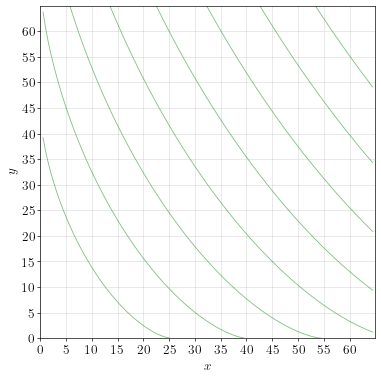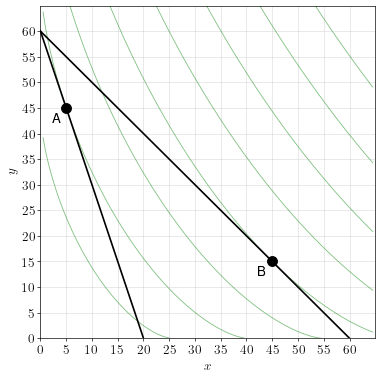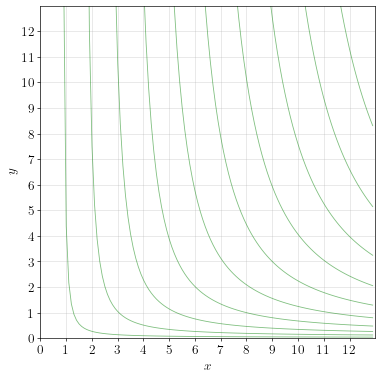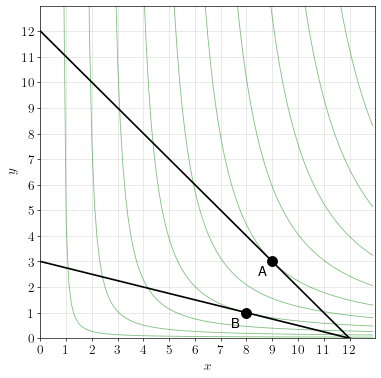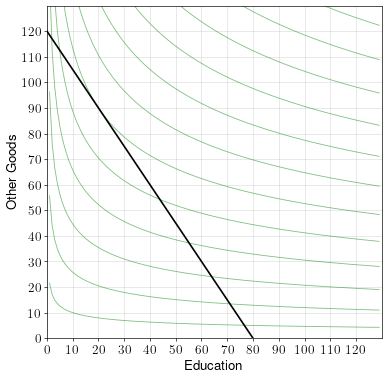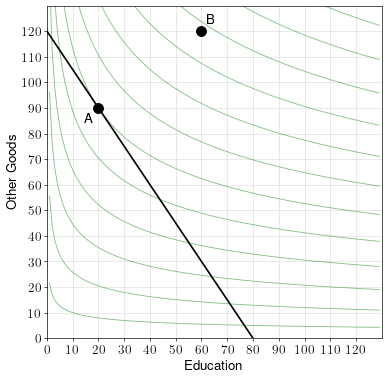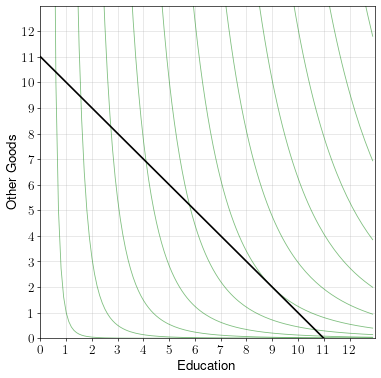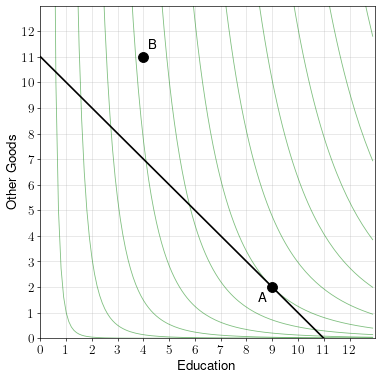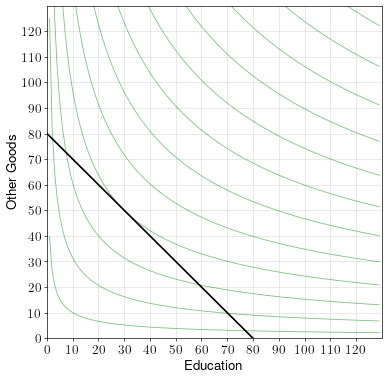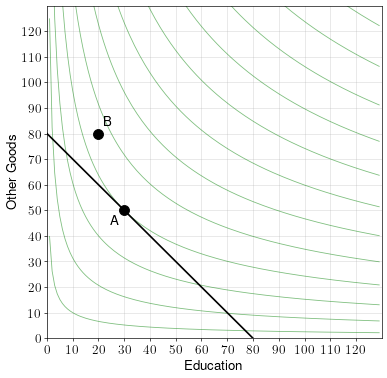Consumer Choice Theory: Applications
In this lecture we explore a few applications of consumer choice theory, mainly using the tools of graphical analysis. There are, of course, many other applications of the general theory.
Assessing price changes
Consumer choice theory can be used to understand how consumers respond to price changes. In particular, it can be used to illustrate complementarity vs. substitutability between goods.
As a reminder:
- Two goods are complements if the consumption of one good goes down when the price of the other rises.
- Two goods are substitutes if the consumption of one good goes up when the price of the other rises.
Example: Substitutes
A consumer with income \(I=60\) has utility over two goods, \(x\) and \(y\), shown by the indifference curves below.
The price of the goods are initially \(p_x=3\) and \(p_y=1\). One day, the price of good \(x\) changes to \(p_x^\prime=1\).
- Draw the initial budget constraint and label the optimal point A.
- Draw the budget constraint after the price change. Label the optimal point B.
- Did the consumption of \(x\) increase or decrease? What about for \(y\)?
- Are \(x\) and \(y\) substitutes or complements at these price levels?
Answer.
The budget constraints and optimal points in both periods will look as follows:
This shows that consumption of \(x\) increased and consumption of \(y\) decreased.
Since the consumption of \(y\) decreased in response to a decrease in the price of \(x\), the two goods are substitutes.
Example: Complements
A consumer with income \(I=12\) has utility over two goods, \(x\) and \(y\), shown by the indifference curves below.
The price of the goods are initially \(p_x=1\) and \(p_y=1\). One day, the price of good \(y\) changes to \(p_y^\prime=4\).
- Draw the initial budget constraint and label the optimal point A.
- Draw the budget constraint after the price change. Label the optimal point B.
- Did the consumption of \(x\) increase or decrease? What about for \(y\)?
- Are \(x\) and \(y\) substitutes or complements at these price levels?
Answer.
The budget constraints and optimal points in both periods will look as follows:
This shows that consumption of \(x\) and \(y\) both decreased.
Since the consumption of \(x\) decreased in response to an increase in the price of \(x\), the two goods are complements.
Economic Insight
Whether two goods are substitutes or complements depends on the shape of the indifference curves (which in turn depend on the form of the utility function).
Public vs. private schools
Consumer choice theory can be used to understand how parents choose between private and public schools. It can also be used to assess the impact of public education.
Public vs. Private School Example 1
A family can spend their income on either education or other goods. The diagram below shows the family’s budget constraint when only private school options are available, as well as their indifference curves over education and other consumption.
A public school option is also available which provides 60 units of education for free.
- On the diagram, label the optimal private school option A and label the public school option B.
- Which offers higher utility, public or private?
- Which option will the family choose?
- If the public school option were removed, would this increase or decrease the amount of education consumed?
Answer.
The optimal private school option is labeled A and the public school option is labeled B.
It can be seen from the diagram that point B has higher utility than point A, so the family will choose the public school option.
Since point B has 60 units of education and point A has 20, removal of the public school will decrease education consumption.
Public vs. Private School Example 2
A family can spend their income on either education or other goods. The diagram below shows the family’s budget constraint when only private school options are available, as well as their indifference curves over education and other consumption.
A public school option is also available which provides 4 units of education for free.
- On the diagram, label the optimal private school option A and label the public school option B.
- Which offers higher utility, public or private?
- Which option will the family choose?
- If the public school option were removed, would this increase or decrease the amount of education consumed?
Answer.
The optimal private school option is labeled A and the public school option is labeled B.
It can be seen from the diagram that point A has higher utility than point B, so the family will choose the private school option.
Since the family chooses private school, removing the public school option wouldn’t change the amount of education consumed.
Public vs. Private School Example 3
A family can spend their income on either education or other goods. The diagram below shows the family’s budget constraint when only private school options are available, as well as their indifference curves over education and other consumption.
A public school option is also available which provides 20 units of education for free.
- On the diagram, label the optimal private school option A and label the public school option B.
- Which offers higher utility, public or private?
- Which option will the family choose?
- If the public school option were removed, would this increase or decrease the amount of education consumed?
Answer.
The optimal private school option is labeled A and the public school option is labeled B.
It can be seen from the diagram that point B has higher utility than point A, so the family will choose the public school option.
Since point B has 20 units of education and point A has 30, removal of the public school option would actually cause the families to choose more education.
Economic Insight
Public provision of education can lead to an increase or a decrease in the optimal level of education chosen by families. Whether public schools increase or decrease education depends on the families’ preferences over education vs. consumption.
